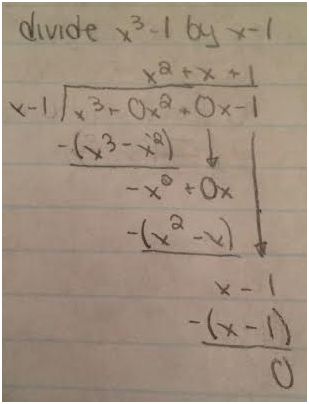Real and Complex Zeros of Polynomial Functions:
The Fundamental Theorem of Algebra states that if
f(x) is a polynomial of degree
n, where
n > 0,
f has at least one zero in the complex number system.
It can be determined from this, that in the complex number system, (real and non-real numbers) every
nth-degree polynomial function has exactly
n zeros.
For example, it can be determined that,
has precisely 4 total zeros, real and/or non-real, because the leading coefficient is 4.
The zeros that an nth-degree polynomial has can be all the same, can be all different, or can be a mixture of the two.
For example:
The function
has 3 zeros. All of the zeros happen to be 2, therefore it has a multiplicity of 3.
The function
also has 3 zeros. These zeros are 2, 3, and 4, so they are all different, however.
The function
has 4 zeros. Two of the zeros are 2, so 2 has a multiplicity of 2. The other 2 zeros are complex numbers. They are (2 + i) and (2 - i).
*It is important to note that when a function has a complex zero, in the form a + bi, the conjugate of that complex zero, a - bi, is also a zero in the function. For example, if 5+3i is a zero, then 5-3i is a zero as well.
Graphs Showing Real and Complex Zeros of Polynomial Functions:
The Fundamental Theorem of Algebra can be shown in graphs as well.
In this example,
is graphed.
It can easily be seen that this function has 4 zeros, just like it should. These zeros are all real.
If this graph was moved down 4 units however, it would look like this:
In this graph, there are also 4 real zeros, but it is harder to see, because 0 has a multiplicity of 2, so the graph is tangent to the x-axis.
If the original graph was moved down 6 units, it would look like this:
This graph still has 4 zeros like the others, but only 2 are visible. This is because only 2 of the zeros are real, and two are non-real. The graph has the opportunity to hit the x-axis twice more, but the it curves away from is before it reaches it, so those 2 zeros are imaginary.
If the original graph was moved up 4 units, if would look like this:
This graph once again still has 4 zeros, but all of them are non-real. The graph has the opportunity to hit the x-axis 4 times, but every single time the graph curves away, so the zeros are all imaginary.
Every time the graph curves away from the x-axis, it has the potential to hit the axis twice, therefore the non-real zeros have to be in conjugate pairs.
Finding the Zeros of a Polynomial Function:
First, graph the function,factor it, or use synthetic division to find its real zeros. Then take the remaining polynomial, after factoring out the real zeros, and find x when f(x) = 0.
The following will show an example of finding the zeros of a polynomial function:
Find the zeros of:
Using synthetic division, you can determine that -2 is a zero, and 1 is a zero with a multiplicity of 2.
The remaining polynomial should be:
Take this polynomial and find x when f(x) = 0.
2i and -2i are also zeros of the polynomial function.
Therefore the 5 zeros of the 5th-degree polynomial function are 2, 1, 1, -2i and 2i.
Finding a Polynomial with Given Zeros:
To find a polynomial with given zeros, just simply find the factors of the polynomial by writing x minus the zero for each zero, and multiply those factors together to get a polynomial function.
The following will show an example of finding a polynomial with given zeros:
The given zeros are -1, 3, and 4+2i. Find a 4th-degree polynomial.
First, we know that since 4+2i is a zero, its conjugate pair, 4-2i must also be a factor.
To set up the function, convert the zeros into factors of the polynomial function, looking like this:
Which can be simplified to:
From there, just multiply the factors together to get the polynomial function.
The zeros of -1, 3, 4+2i, and 4-2i can be defined as the 4th-degree polynomial above.
Works Cited
"Desmos Graphing Calculator." Desmos Graphing Calculator. N.p., n.d.
Web. 19 Jan. 2015.
Hostetler, Robert P., Bruce H. Edwards, and David C.
Falvo. "The Fundamental Theorem of Algebra." Precalculus with Limits: A Graphing Approach. By Ron Larson. 3rd
ed. Boston, NY: Houghton Mifflin, 2001. 182-86. Print.

.gif)


.gif)
.gif)
.gif)









































